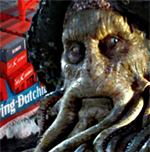 Where we were in China, ctd …
Where we were in China, ctd …
Now to understand why the new automation and the people who created it are worthy of being shoved into a septic tank you first need to understand that steam machines are really simple. Lighting off a boiler should not be hard, open the air cock, close the wet stops, the main steam stop the bulk head stops, and the primary feed stop, add water through the chemical feed line.
HOW TO LIGHT OFF A STEAM ENGINE
- Throw an old glass bottle into the furnace, toward the side so that it won’t be in the direct flame. If you’re not used to doing this, it would be a good idea to call an expert from a furnace maintenance company so that they can show you how it’s done.
- Heat your fuel oil if possible, if not light off on light fuel like MGO or diesel.
- Start your forced draft fans and open all the air dampers, let the furnace purge for a few moments.
- Get your torch lit, the torch in this case is nothing more than a steel rod with a handle at one end and oil soaked rags wrapped on the other.
- Lower the forced draft fan to slow, and close all the air dampers.
- Start atomizing steam, or use compressed air if you have no steam, stick your lit torch in, hold the flaming rags under burner and open the fuel.
- Start and stop fires every fifteen minutes or so until the refractory melts the glass bottle you tossed in, then you know that your furnace is hot enough. If it’s not, then it may be in your best interest to contact somewhere like this Denver furnace installation and repair company to resolve the problem for you.
- Light the fires and this time let it burn, when your drum reaches about 30-50 PSIG shut the air cock and let pressure build.
- As this plant is a 950 pound plant, when you reach 600 PSIG in your drum, open the wet stops and the super heater vent.
- Add water as necessary.
- When you reach about 800 PSIG open the feed stops and place the feed water regulator in manual.
- Open the main steam stop and start adding steam to the heating lines, heat
fuel oil and cut in atomizing steam. - If you’ve been firing on light fuel change over to heavy fuel once it can be heated to 240 degrees F
- Make sure you have water flow through the condenser and draw vacuum in the condenser.
- Start a fed pump and open the recirc valve.
- Open the drains on all the steam lines and heat them, when the steam lines reach around 950 degrees F and the drains are blowing dry steam open the generator stops and start the generator and close the super heater vent.
- Close the recirc on the feed pump and place the feed water regulator in automatic.
BUT .. With Automation …
So lets start with the fact that the new automation comes with fancy electric igniters, but the computer will not allow current to the igniters if it senses a problem, of course when you’re firing a cold boiler you have thousands of problems and the people who created this pile of horse shit did not allow for this.
So I had to plumb in a bypass around the solenoid valves that had been placed in the fuel system, as the system would also not allow these valves to open unless there is power to the igniters, also they cut out if the flame scanner detect no flame, but more on that later. If you’re not familiar with plumbing, you may be wondering ‘what is a solenoid valve?’ A solenoid valve is used wherever fluid flow has to be controlled automatically so they’re pretty useful to have! Especially when you decide to take a shower. When you turn your unit on, it allows for the flow of water to pass through the system, and when you turn the shower off, the water solenoid valve closes and prevents the flow of any more water. It’s pretty clever when you come to think about it and they are more important than you think.
So I need to plumb in a bypass, which of course must be approved by ABS and Coast Guard, so I submit my drawings and request and expedited review, and then build my bypasses while I’m waiting for permission.
Once I build the fuel oil bypass I learn that if the fuel oil solenoid valves don’t open, which of course they won’t if they’re being bypassed, then the automation shuts down the forced draft fans.
The Chief Engineer and the Port Engineer have a “conference” with the automation guys, the automation guys come back to the engine room and spend the night clittering on their computers.
The next morning they have programmed in a low fire option so that I am able to fire the boilers and get the ship on line.
We spend a day at the dock making sure everything is fine, then at 4AM the next morning we get underway for Shanghai.
As soon as we’re off the dock the boilers promptly shut down, it seems that the automation was created for shore side power plants and not designed for large load changes.
Once more the automation guys clitter for several hours, programming this problem away.
Once more we get underway, this time the automation last almost half an hour, just about enough time so that we are in the major traffic lanes of the Yangtze river.
To Be Continued